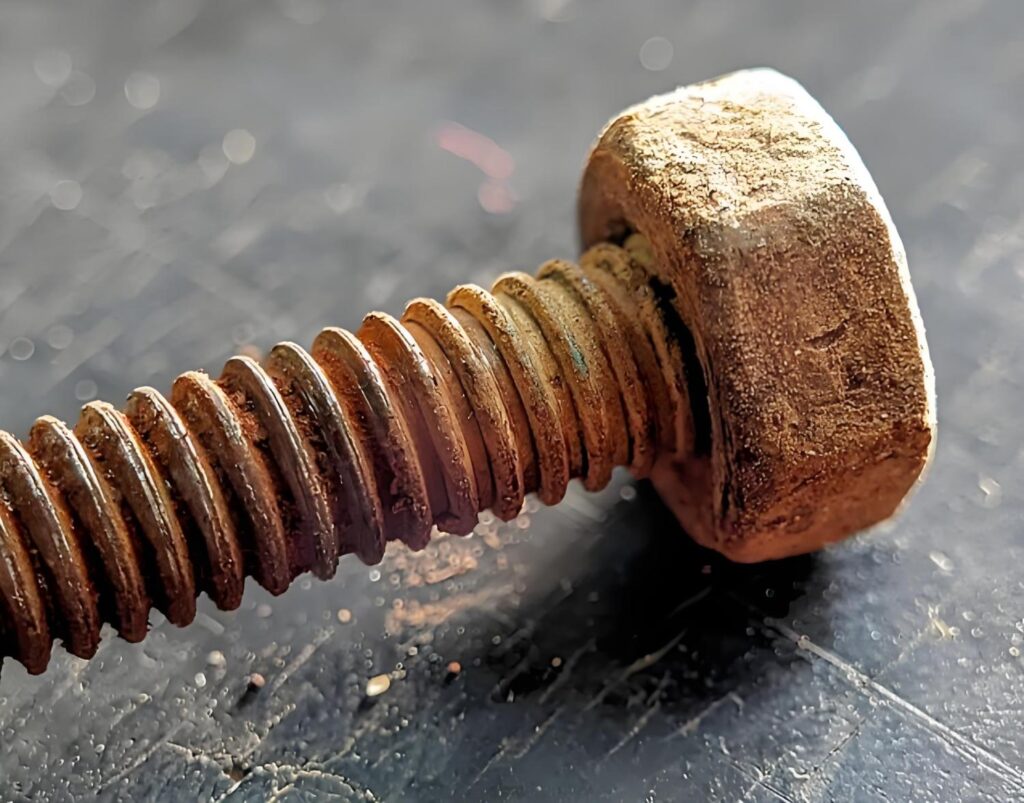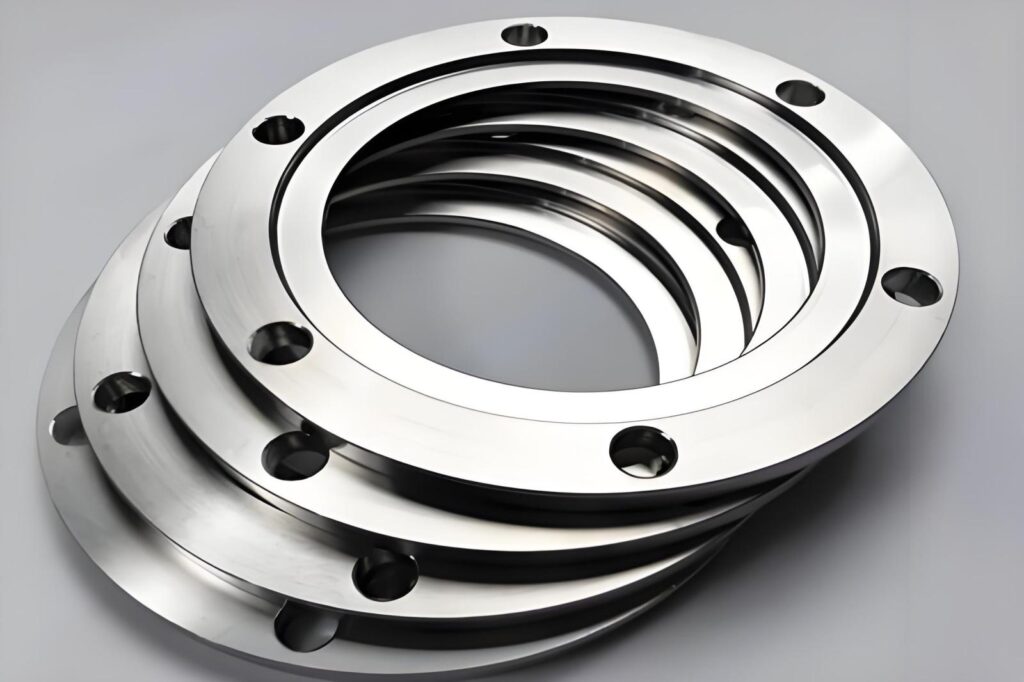Carbon steel is widely used in manufacturing for its strength and workability. However, it has a downside: carbon steel will rust. Carbon steel is essentially an iron–carbon alloy, and iron readily oxidizes to form rust. In fact, “iron reacts with oxygen under the action of oxygen and moisture to form iron oxide (rust)” In plain terms, unprotected carbon steel will eventually rust when exposed to air and water. This article explores why carbon steel rusts, what factors accelerate corrosion, and how to protect or restore carbon steel parts.
What Is Carbon Steel?
Carbon steel is an alloy primarily composed of iron and carbon, with trace amounts of other elements like manganese, silicon, or sulfur. Its carbon content, typically ranging from 0.05% to 2.0%, determines its strength, hardness, and susceptibility to corrosion. Unlike stainless steel, which contains chromium for rust resistance, carbon steel lacks significant corrosion-resistant elements, making it more prone to rust under certain conditions. Understanding its composition is key to answering the question: does carbon steel rust?
Carbon steel’s affordability and durability make it a go-to material for tools, machinery, automotive parts, and structural components. However, its interaction with environmental factors can lead to rust, a form of corrosion that can compromise its integrity. Let’s explore this phenomenon in detail.
Will Carbon Steel Rust?
Yes, carbon steel can rust when exposed to moisture, oxygen, and certain environmental conditions. Rust, scientifically known as iron oxide (Fe₂O₃), forms when iron in carbon steel reacts with oxygen in the presence of water or moisture. This electrochemical process, called oxidation, breaks down the metal’s surface, leading to the characteristic reddish-brown coating.
The likelihood of rust depends on several factors, such as the environment, the type of carbon steel, and whether protective measures are in place. For instance, carbon steel exposed to humid or salty air is more likely to corrode than steel kept in a dry, controlled environment. While rust is a common concern, understanding the conditions that trigger it can help users take proactive steps to protect their carbon steel components.
Factors Affecting Rust on Carbon Steel

Several environmental and material-specific factors influence whether and how quickly carbon steel rusts. By understanding these variables, industries and individuals can better manage corrosion risks.
Environmental Conditions
Moisture is the primary catalyst for rust. When carbon steel is exposed to water—whether through rain, humidity, or submersion—rust is more likely to form. Coastal areas with high salinity in the air accelerate corrosion due to the presence of chloride ions, which enhance the electrochemical reaction. Temperature also plays a role; warmer conditions can speed up rust formation, especially in humid environments.
Carbon Content and Alloy Composition
The carbon content in steel affects its corrosion resistance. High-carbon steel, used in tools and blades, is often more brittle and can corrode faster under certain conditions due to its microstructure. Low-carbon steel, common in structural applications, may corrode more slowly but is still vulnerable without protection. The absence of corrosion-resistant elements like chromium or nickel makes carbon steel more susceptible than stainless steel.
Surface Condition
The condition of the steel’s surface impacts rust formation. Polished or coated surfaces resist corrosion better than rough, untreated ones. Scratches, dents, or impurities on the surface can create sites where rust initiates, as these areas trap moisture and oxygen.
Exposure Time
The duration of exposure to corrosive elements determines the extent of rust. Brief exposure may cause minimal surface rust, while prolonged contact with water or humid air can lead to severe corrosion, weakening the material.
Types of Carbon Steel Corrosion
Corrosion in carbon steel manifests in various forms, each with distinct characteristics and implications. Recognizing these types helps in diagnosing and addressing rust issues effectively.
Uniform Corrosion
Uniform corrosion occurs evenly across the surface of carbon steel when exposed to moisture and oxygen. It’s the most common form of rust, often seen in outdoor equipment or structures left unprotected. While it may not immediately compromise the material, prolonged uniform corrosion can reduce thickness and strength.
Pitting Corrosion
Pitting corrosion creates small, localized pits or holes on the steel’s surface, often caused by chloride exposure in salty environments. These pits can penetrate deeply, weakening the material and leading to structural failure if untreated. Pitting is particularly concerning for machined parts, where precision is critical.
Crevice Corrosion
Crevice corrosion occurs in confined spaces, such as joints or under gaskets, where stagnant water collects. The lack of oxygen in these areas creates a differential that accelerates corrosion. This type is common in complex assemblies or poorly maintained equipment.
Galvanic Corrosion
When carbon steel is in contact with a more noble metal (like copper or stainless steel) in the presence of an electrolyte (e.g., water), galvanic corrosion can occur. Carbon steel acts as the anode, corroding faster to protect the other metal. This is a concern in mixed-metal applications.
How to Prevent Carbon Steel from Rusting
Preventing rust is essential to extending the lifespan of carbon steel components. Several practical methods can protect the material from corrosion.

Protective Coatings
Applying coatings like paint, varnish, or powder coating creates a barrier between steel and its environment. These coatings prevent moisture and oxygen from reaching the surface. For high-performance applications, galvanizing (coating with zinc) or applying specialized anti-corrosion coatings can provide long-term protection.
Regular Maintenance
Routine cleaning and inspection can catch early signs of rust before they escalate. Removing dirt, grease, or moisture from carbon steel surfaces reduces corrosion risk. For machinery, regular lubrication can also minimize friction-related damage that exposes bare metal.
Environmental Control
Storing carbon steel in dry, controlled environments minimizes exposure to moisture. Dehumidifiers or climate-controlled storage can be effective for sensitive components. In outdoor settings, using covers or shelters can shield steel from rain and humidity.
Cathodic Protection
In applications like pipelines or marine equipment, cathodic protection systems use sacrificial anodes (e.g., zinc or magnesium) to corrode in place of the carbon steel. This method is highly effective in harsh environments.
Alloying and Material Selection
While carbon steel lacks inherent corrosion resistance, selecting the right grade for the application can help. For instance, low-carbon steel may be less prone to rapid corrosion in certain conditions. In some cases, opting for stainless steel or other alloys may be more cost-effective for corrosion-prone environments.
How Long Does Carbon Steel Take to Rust?
The time it takes for carbon steel to rust varies widely based on environmental conditions, steel composition, and protective measures. In a humid, salty environment, surface rust can appear within hours or days of exposure. For example, carbon steel left outdoors in a coastal area may show signs of corrosion within 24–48 hours. In contrast, steel in a dry, indoor setting may take months or years to develop noticeable rust, especially if coated or maintained.
The rate of rusting also depends on the type of corrosion. Uniform corrosion progresses slowly, while pitting or crevice corrosion can cause rapid, localized damage. Factors like temperature, exposure duration, and the presence of pollutants (e.g., sulfur dioxide in industrial areas) can accelerate the process. Regular maintenance and protective coatings can significantly delay or prevent rust formation.
If Carbon Steel Has Rusted, How to Deal with It?
When rust appears on carbon steel, prompt action can prevent further damage and restore the material’s functionality.
Surface Cleaning
Mild rust can often be removed with mechanical methods like wire brushing, sanding, or abrasive blasting. For small areas, a wire brush or sandpaper can effectively remove surface rust. For larger or heavily rusted surfaces, sandblasting or grinding may be necessary to restore a clean surface.
Chemical Treatments
Chemical rust removers, such as phosphoric acid or vinegar, can dissolve rust without damaging the underlying steel. These treatments are ideal for intricate parts or areas difficult to reach with mechanical methods. After treatment, rinse and dry the steel thoroughly to prevent further corrosion.
Repainting or Recoating
Once rust is removed, applying a fresh protective coating is critical to prevent recurrence. Primers designed for metal, followed by a topcoat of paint or anti-corrosion coating, can restore protection. Ensure the surface is clean and dry before applying coatings for optimal adhesion.
Replacement
In cases of severe corrosion, where the steel’s structural integrity is compromised, replacement may be the only option. This is particularly true for pitted or deeply corroded components in critical applications like machinery or infrastructure.
Why Trust Precionn for Your Carbon Steel Needs?
When it comes to machining and working with carbon steel, Precionn stands out as a trusted industry leader. With years of expertise in precision machining, Precionn delivers high-quality carbon steel components tailored to diverse applications, from automotive parts to industrial machinery. Our commitment to quality ensures that every piece meets stringent standards, with surface treatments and coatings available to enhance corrosion resistance.
Precionn understands the challenges of rust and corrosion in carbon steel applications. Our team offers customized solutions, including expert advice on material selection, protective coatings, and maintenance practices to maximize the lifespan of your components. Visit our website to explore our services and discover how Precionn can support your next project with precision and reliability.
FAQs About Carbon Steel Rust
Yes, carbon steel rusts in water, especially if submerged for extended periods. The presence of oxygen in water triggers the oxidation process, leading to rust. Freshwater causes rust more slowly than saltwater, which contains chloride ions that accelerate corrosion. Protective coatings or cathodic protection can mitigate rust in water-exposed applications.
High carbon steel, used in tools and blades, is prone to rust due to its higher carbon content and lack of corrosion-resistant elements. Its microstructure can make it more susceptible in humid or salty environments. Regular maintenance, such as drying and oiling, is essential for high-carbon steel items like knives.
Low carbon steel, common in structural applications, also rusts but may corrode more slowly than high-carbon steel due to its lower carbon content and smoother microstructure. However, without protective measures, it remains vulnerable to moisture and oxygen.
Carbon steel exposed to outdoor conditions, such as rain, humidity, or salty air, is highly likely to rust. The rate depends on the climate and exposure duration. Protective coatings, regular maintenance, or shelters can significantly reduce outdoor rusting.
Unlike carbon steel, stainless steel contains chromium (at least 10.5%), which forms a passive oxide layer that resists rust. While carbon steel is stronger and more affordable, it requires protective measures to prevent corrosion. Stainless steel is often preferred in corrosive environments, but carbon steel is ideal for applications prioritizing strength and cost, provided rust prevention is addressed.

